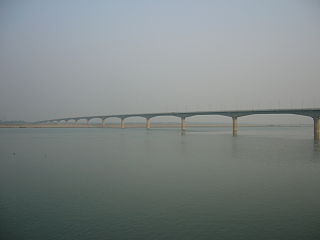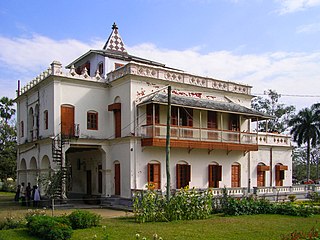
The Baul are a group of mystic minstrels of mixed elements of Sufism, Vaishnavism and Tantra from Bangladesh and the neighboring Indian states of West Bengal, Tripura and Assam's Barak Valley and Meghalaya. Bauls constitute both a syncretic religious sect of troubadours and a musical tradition. Bauls are a very heterogeneous group, with many sects, but their membership mainly consists of Vaishnava Hindus and Sufi Muslims. They can often be identified by their distinctive clothes and musical instruments. Lalon Shah is regarded as the most celebrated Baul saint in history.

The Khulna Division is the second largest of the eight divisions of Bangladesh. It has an area of 22,285 km2 (8,604 sq mi) and a population of 17,416,645 at the 2022 Bangladesh census. Its headquarters and largest city is Khulna city in Khulna District.

Lalon, also known as Lalon Shah, Lalon Fakir, Shahji and titled Fakir, Shah, was a prominent Bengali spiritual leader, philosopher, mystic poet and social reformer born in British India. Regarded as an icon of Bengali culture, he inspired and influenced many philosophers, poets and social thinkers including Rabindranath Tagore, Kazi Nazrul Islam and Allen Ginsberg. Lalon's philosophy of humanity rejects all distinctions of caste, class, and creed and takes stand against theological conflicts and racism. It denies all worldly affairs in search of the soul and embodied the socially transformative role of sub-continental Bhakti and Sufism.

Kushtia District is a district in the Khulna administrative division of western Bangladesh. Kushtia is the second largest municipality in Bangladesh and the eleventh largest city in the country. Kushtia has existed as a separate district since the partition of India. Prior to that, Kushtia was a part of Nadia district. Kushtia is the birthplace of many historical figures including Mir Mosharraf Hossain (1847–1912), Bagha Jatin (1879–1915) and Lalon (1774–1890). Nobel laureate poet Rabindranath Tagore lived his early life at Shelaidaha.

Kushtia is a city in the Khulna Division of southwestern Bangladesh. Kushtia is the second largest municipality in Bangladesh and the eleventh largest city in the country. The second largest city in Khulna division. It is one of the commercial cities. It serves as the headquarters of Kushtia Sadar Upazila and Kushtia District.

Harinath Majumdar, better known as Kangal Harinath, was a Bengali journalist, poet, writer, and Baul singer. He is the writer of Bijoy Basanta (1859), which is in the list of the first published Bengali novels.

Lalon Shah Bridge, locally known as Pakshey Bridge is a road bridge in Bangladesh over the river Padma, constructed by China Major Bridge Engineering Co., Ltd., situated between Ishwardi Upazila of Pabna on the east, and Bheramara Upazila of Kushtia on the west. Named after early 19th-century mystic poet Lalon Shah of Chhewuriya, Kushtia District, the bridge was completed in 2004.

Kumarkhali is an upazila of Kushtia District in the Division of Khulna, Bangladesh. It is famous for the Shelaidaha area, where the poet Rabindranath Tagore spent a considerable time of his youth.
Daulatpur is an upazila of Kushtia District in the Division of Khulna, Bangladesh. Daulatpur Thana was formed in 1854 and it was turned into an upazila in 1983.
Khoksa is an upazila of Kushtia District in the Division of Khulna, Bangladesh.
Mirpur is an upazila of Kushtia District in the Division of Khulna, Bangladesh. Mirpur Thana was formed in 1885 and it was turned into an upazila in 1983.
Ishwardi is an upazila of Pabna District in Rajshahi Division. It is the westernmost upazila of Pabna district. This upazila is a dynamic administrative region with a rich cultural heritage and significant economic importance. Situated in the fertile Gangetic floodplain, Ishwardi Upazila boasts a landscape shaped by the Ganges and its tributaries. This region is renowned for its agricultural productivity, particularly in the cultivation of rice, vegetables, litchi, sugarcane and other crops. Ishwardi upazila is not only an agricultural hub but also home to various industries, including the Ruppur Nuclear Powerplant and Ishwardi Export Processing Zone, which have contributed to its economic growth. With a harmonious blend of rural and urban areas, this upazila offers a glimpse into the traditional lifestyle and modern developments that coexist within its boundaries.
Durgapur is an upazila of the Rajshahi District, located in Bangladesh's Rajshahi Division. It is named after the town of Durgapur.
Moushumi Akhter Salma, commonly known as Salma Akhter, is a Bangladeshi folk singer. She rose to fame in 2006 after winning the second season of "Closeup 1 Tomakei Khujchhey Bangladesh", a television series broadcast on NTV.
Haramoni is the title of 13-volume collection of Bengali folksongs by Muhammed Mansooruddin. Mansooruddin collected more than 5,000 folksongs from different parts of Bengal. He compiled them in a series of volumes and the titled them after the name of a regular section of monthly literary magazine Probashi that was earmarked for publishing folk songs collected from rural areas. Haramoni literally means Lost Jewels.
Gaganchandra Dam, mostly known as Gagan Harkara, was a Bengali Baul poet after the tune of whose famous song "Ami Kothay Pabo Tare" Rabindranath Tagore composed "Amar Shonar Bangla", the national anthem of Bangladesh.
Khoda Box was a Bangladeshi Baul singer and composer. He was awarded Ekushey Padak by the Government of Bangladesh in 1990 for his contribution to Baul music.
Shahed Chowdhury was a Bangladeshi film director. He directed many Dhallywood movies.

Union councils of Kushtia District are the smallest rural administrative and local government units in Kushtia District of Bangladesh. The district consists of 5 municipalities, 6 upazilas, 57 ward, 70 mahalla, 71 union porishods, mouza 710 and 978 villages.










